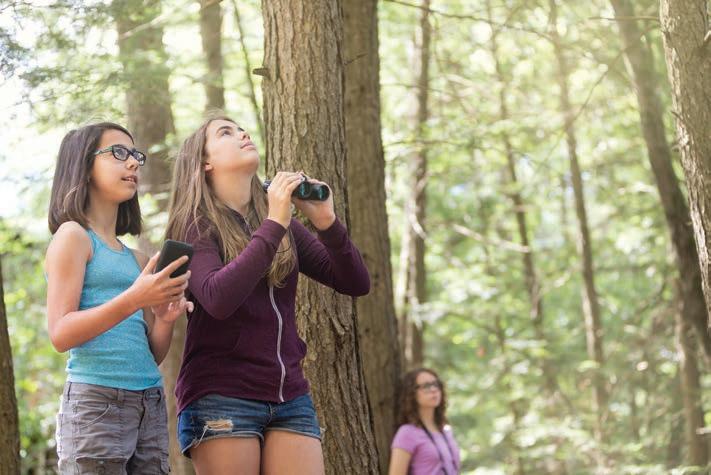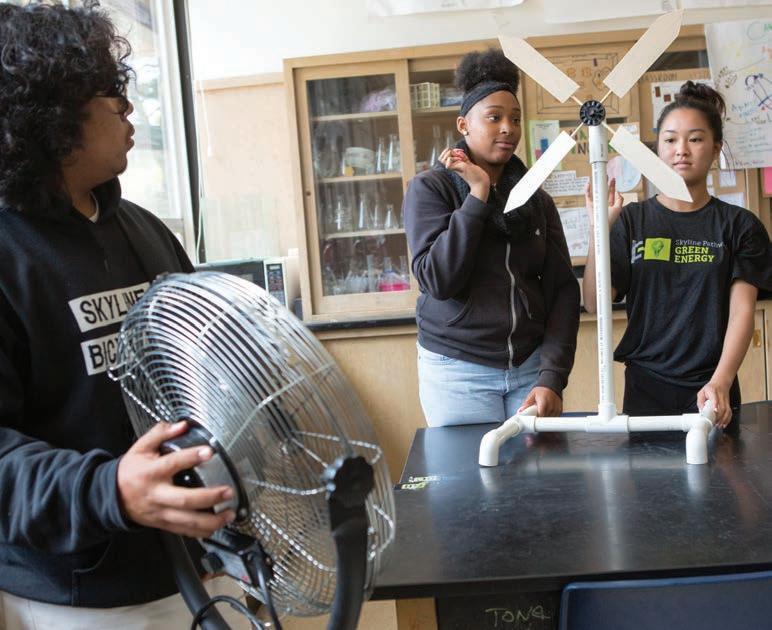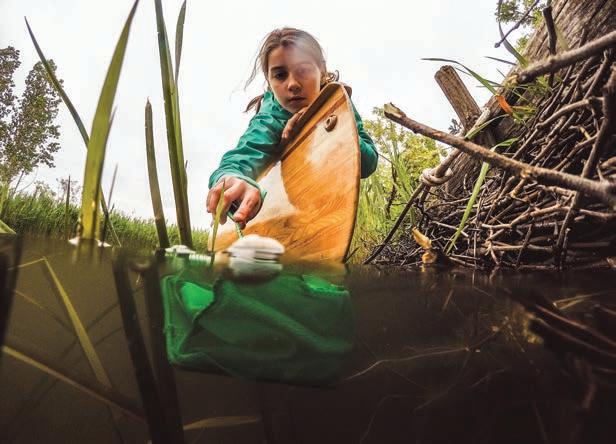
13 minute read
cover
Citizen scientists technology is blurring the lines between students and scientists
By Nicole Krueger
Advertisement
For students in Iqaluit, Nunavut – a fly-in community in Northern Canada – climate change isn’t an abstract concept measured in degrees or inches. It’s a tangible reality, visible in the sinking pylons that support their homes and the changing landscape that makes traditional hunting grounds inaccessible, restricting their food supply.
“They’re living it. They’re not just talking about polar bears losing their habitat, but students are seeing that happen. They’re seeing polar bears come into their community where they’re not supposed to be,” says Mali Bickley, classroom collaboration specialist for TakingITGlobal, a nongovernmental organization (NGO) that uses technology to empower students to tackle global challenges.
Isolated on the wrong side of the digital divide, their experiences and observations have gone largely unnoticed by the rest of the world. But that changed for students from Aqsarniit Middle School when they used videoconferencing technology to connect with Lee Gambol from the Cleveland Museum of Natural History. Not only did Gambol teach them the science behind the environmental changes they were witnessing, but the students got to share their firsthand account of what climate change looks like on the ground.
“Students actually taught the expert something she had absolutely no idea about. It was an incredible learning experience,” Bickley says. “When they had their voices heard by a climate change expert in the U.S., it really validated their understanding and their voice surrounding climate change.”
Across the globe, there’s a new synergy forming between students and scientists. Learners of all ages are forming collaborative partnerships with working scientists, participating in authentic scientific inquiry and contributing meaningful data to citizen science projects. Using a broad range of technologies, from smartphones and tablets to videoconferencing and collaborative websites, they’re helping to build and analyze vast global datasets and devise solutions to real-world problems.
In the process, they’re learning that despite their youth, they have something valuable to offer the scientific community.
“There’s a huge opportunity for our kids to not just stand by and read from a textbook, but for them to see that science is happening now, right in front of them, right outside the door, and they have the ability to contribute to that,” says Janice Mak, K-12 science curriculum specialist for Paradise Valley Unified School District in Arizona.
“Everything technology enables us to do has really democratized education and broken down barriers. It’s causing us to question and challenge what we traditionally think of as scientists.”
students and scientists working together How much water once existed on Mars? How did the planet make the transition to the cold and dry climate that exists today? As scientists puzzle over these questions, they’ve begun bringing students on board to help study data collected by the Mars Odyssey spacecraft orbiting the planet.
A few years ago, seventh and eighth graders from Explorer Middle School in Arizona joined Arizona State University’s (ASU) Mars Student Imaging Project. They selected a specific region of the planet – the Valles Marineris – and launched an inquiry into how the abundance of water-related minerals differed between the deepest and shallowest sections of the valley. They hypothesized that they would find the greatest abundance in the deeper parts of the valley because water collects in low-lying areas.
To facilitate their research, scientists captured a current image of the region using the Odyssey’s THEMIS camera, which images Mars simultaneously in five visual and 10 infrared bands or colors. Students analyzed the image, comparing it to past images of the same region, and collected more than 1,000 data points, which they graphed to identify correlations between elevation and the abundance of water-related minerals.
Their research culminated in a paper, which was peer reviewed by a planetary geologist, and a two-day field trip to ASU, where they further investigated and tested their hypothesis under the guidance of an ASU scientist.
“One powerful piece of the equation is students seeing themselves as part of

the collective inquiry and helping to make advances,” says Mak, who chose the project for her students because of its alignment with the Next Generation Science Standards (NGSS). “They’re no longer just reading about scientific discoveries in a textbook. They can see themselves as a part of the way things are transforming.”
Worldwide, hundreds if not thousands of citizen science projects are tapping ordinary people, including students, to help observe, collect and classify data to pinpoint areas for closer study. While NASA satellites can capture thousands of terabytes of data per year, scientists also need on-the-ground measurements to form a complete picture of Earth’s complex systems. Citizen science offers a way to ground-troop their data. Through the GLOBE Observer program, whose goal is to study the environment and changing climate, students from more than 119 countries are helping to monitor onthe-ground environmental conditions for NASA, contributing more than 150 million measurements over the past two decades.
“If you want to learn science, you need to do science. This is real science, and students are involved in the entire scientific process,” says coordinator Holli Riebeek. “They go out and ask a question, and they have procedures that enable them to take valid scientific observations that a real-world scientist could use. They’re actually observing the real world and drawing their own conclusions.”
And that’s just one example. Using websites like SciStarter and Zooniverse as a jumping-off point, educators can find authentic research projects for almost any subject or geographic location. Students can take photos of their backyards to help identify potential mosquito breeding sites, analyze images of space for anomalies that could indicate a hidden planet in our solar system, or use their smartphones to measure the size of trees. They can also access realworld scientific datasets for use in their own classroom projects.
“Citizen science projects provide students the opportunity to ask and answer questions, and experience true scientific discovery and the joy of learning something completely new – qualities often stripped from science education that relies on demonstrations of concepts rather than inquiry and scientific skill-building,” says Christine L. Goforth, head of citizen science at the North Carolina Museum of Natural Sciences in Raleigh.
real-world science? there’s an app for that Students at Medford Memorial Middle School in New Jersey wanted to help reduce the threat of mosquito-transmitted disease in their region, where 44 cases of the West Nile virus were reported in 2018. They decided to launch an investigation into where disease-bearing mosquitoes might breed during their active season.
photo courtesy of allison shelley/the verbatim agency for american education: images of teachers and students in action.

Through Mosquito Habitat Mapper, a NASA-sponsored citizen science project that invites teachers and students to scout their communities for potential breeding grounds, they learned how to identify and report such locations via an app to help scientists predict future disease outbreaks. Unsatisfied with merely walking around their schoolyard and making on-the-ground observations, however, the students researched how scientists are using drones in Central America and Africa to identify potential breeding areas.
“They decided to use drone technology to fly over six of the schools in their districts and use images from the drones to help them identify where to go and look for mosquito larvae in the spring,” says Dorian Janney, campaign coordinator for the GLOBE Mission Mosquito citizen science community.
Such inquiries wouldn’t have been doable a decade ago. Advances in technology have made powerful data collection tools widely accessible for average citizens, including students. Affordable photography drones are now sold in toy aisles. For less than $10, a smartphone owner can buy an attachment that magnifies images up to 60 times –helpful for identifying different types of mosquito larvae, Janney says.
“The combination of smartphone technology and the internet makes things possible that weren’t possible even 10 years ago,” Riebeek says. “A lot of the tools and sensors people use for science data collection are becoming accessible. We’re not using multi-thousand-dollar sensors anymore. You can get an infrared camera put on your smartphone now.”
Participating in citizen science projects not only helps students think like scientists, but it teaches them that a smartphone can do more than just play YouTube Videos – it can double as powerful data-collection tool.

“They have this powerful tool right in their pocket with a camera and an accelerometer and a magnetometer,” says Ben Smith, supervisor of educational technology at Lincoln Intermediate Unit in Pennsylvania.
“The biggest thing their phones can do is reporting. They can open up an app and take real-time measurements with it and report those out. That’s the best tool there is. They also have the camera so they can take pictures of wildlife and upload them to different sites that study biodiversity. The camera can also be used to capture light pollution. There’s a magnetometer for measuring magnetic field strength and an accelerometer to measure the acceleration of gravity.”
Apps like Google’s Science Journal can help students explore the scientific capabilities of their tablets and smartphones and begin experimenting with the built-in sensors many don’t even realize their devices have. Mak has used the app with kids as young as third grade.
“Putting the power of technology in their hands, connecting it with science and the world around them, and pairing it with the human ability to make observations and from those find patterns – that’s the power,” she says.
from citizen scientists to global citizens The world has lost nearly 20% of its coral reefs to pollution, overfishing and coastal development. Today, more than 60% are now under immediate threat. In Malaysia, whose living reefs diminished 5% between 2012 and 2017, high school students studying the global loss of coral decided to take action.
Students at MARA Junior Science College of Merbok in Kedah, Malaysia, took to the water to pursue their studies. They learned how to snorkel so they could see the effects of coral reef loss firsthand. After Skyping with marine biologist Puteri Nurshazmimi Binti Zaidi, they used Minecraft Education to design a coral cage, a type of underwater device scientists are using to encourage rapid coral growth.
The project culminated in a final dive to submerge their cage and plant new coral to help replenish the local reef population.
They conducted their research in 2019 as part of The Goals Project, a global effort to enlist students in advancing the United Nation’s Sustainable Development Goals (SDGs). The UN identified these 17 global goals, which span a range of social, economic and environmental issues, in 2015 to create a blueprint for a more sustainable future. Last year, more than 1,600 classrooms participated in projects related to the goals, many combining scientific inquiry with environmental stewardship.
“I believe part of the work of teachers is to create a world of global citizens, and one of the best ways to do that is to help them develop an understanding of what’s going on in the world, to interact with others around the world to solve authentic problems,” says Elizabeth Azukas, Ed.D., assistant professor of professional and secondary education for East Stroudsburg University in Pennsylvania.
“We need to focus on implementation of a more global curriculum. That is the world that students live in, and it will continue to become even smaller in some ways. When we’re talking about issues related to the ocean, for example, it becomes really complicated because no one country owns the ocean, and there’s no governing body for the ocean. How do we negotiate those types of things together?”
Teaching the SDGs is just one way educators can use scientific inquiry to craft students into responsible global citizens. Participating in real-world science offers numerous benefits even for students who don’t go on to pursue scientific careers. As voters and environmental stewards, they’ll
be more prepared to make informed decisions about natural resources. They’ll also have a framework to rely on if they ever feel their community is under threat.
“If these students are curious about the air quality of their neighborhood since a new factory moved into their town or are concerned about the impact of local logging being done in the national forest in the surrounding mountains, they will have participated in science studies, collected data and have the necessary experience to begin researching and studying these things for themselves,” science teacher Lynda Jenkins writes in the Cultural Studies of Science Education journal.
In a “post-truth” era, these authentic science experiences can also help ground students in the scientific method as a way of thinking critically and sifting through misinformation.
“Students are collecting their own data and drawing their own conclusions. One of the powerful aspects of citizen science is that when you think about the attack science is undergoing, particularly climate science, we want students to be able to debunk what fake news is by taking their own measurements and doing their own science,” Smith says.
“Students gain an appreciation for the life that’s around them," Smith says, “and that's what serves them best down the line because if they understand how to take these measurements and develop their own conclusions, they’ll be in a better situation to appreciate and also apply those lessons later in life.”
nicole krueger is a freelance writer and journalist with a passion for finding out what makes learners tick.
Tools for teaching real-world science

Interested in bringing more authentic scientific inquiry into the classroom? Below is a starter toolkit to help educators begin integrating citizen science and the UN Sustainable Development Goals (SDGs) into the classroom.
SciStarter: This teacher-friendly site lets educators search more than 3,000 citizen science projects by location, scientific topic and age level. It’s like Match.com for citizen science. scistarter.org
Zooniverse: Another popular platform for people-powered research, Zooniverse connects citizen volunteers of all ages to real-world science projects. zooniverse.org
iNaturalist: A joint venture between the California Academy of Sciences and the National Geographic Society, this app lets users record their observations of the natural world, share them with other naturalists and discuss their findings. inaturalist.org
The GLOBE Program: Educators can browse classroom activities and other free resources for this NASA citizen science project, or they can dive deeper by joining the program, completing the training and implementing GLOBE science protocols in their classrooms. globe.gov
Smithsonian Science for Global Goals: Engage students in inquiry-based experiences in their local community with these field-tested and age-agnostic educational materials related to the SDGs. ssec.si.edu/global-goals
The Goals Project: Join a network of classrooms across the globe as they work in tandem to help advance the SDGs. goalsproject.org
SDGs in Action: Ready to take action on the SDGs? This app lets you invite others to participate in your events and see what others are doing to advance the global goals. sdgsinaction.com








